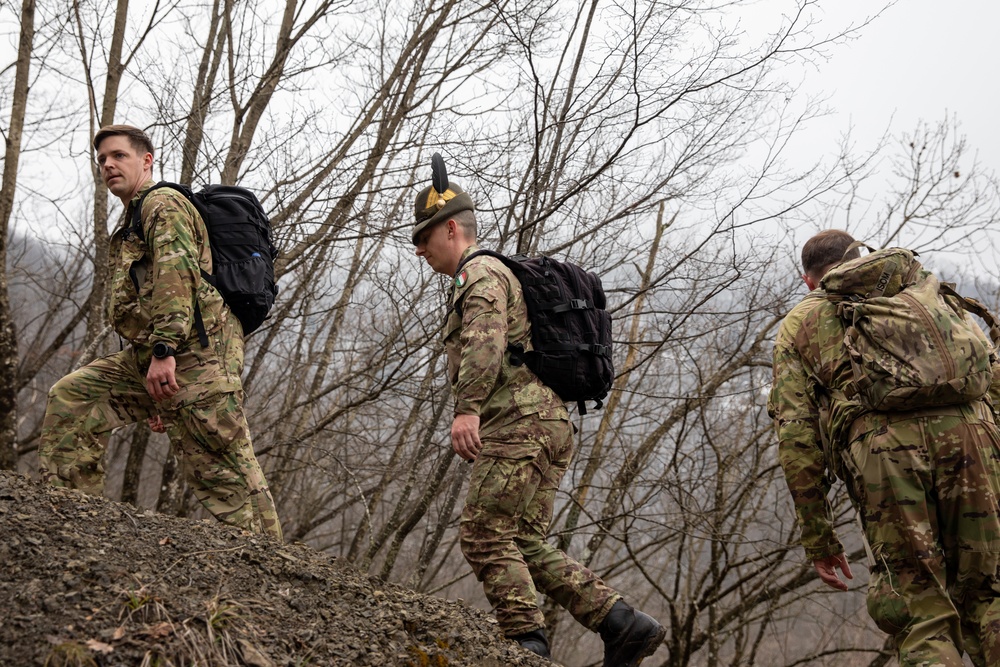BOLOGNA, Italy (Feb. 18-19, 2025) – It was 80 years ago that the Soldiers of the 10th Mountain Division courageously climbed Riva Ridge, a set of steep, prominent peaks in the Northern Apennine Mountain Range. It was a pivotal moment in World War II, forever etching itself into the history of the division.
The infamous Gothic Line – a defense of fortifications across the top of Italy’s ‘boot’ – was held with a strong and tight grip by the Germans, which allowed them to control the high ground and keep the Allies at bay.
The Allies needed a way to take Riva Ridge, which held the German’s observation post, a position used to watch for enemies, direct fire, and warn of approaching soldiers. Defeating this observation post was a critical piece in breaking the Gothic Line, and would enable the Allies to advance further toward Germany and end the Axis’ presence in Italy.
During the night of Feb. 18, 1945, Soldiers with the 10th Mountain Division quietly ascended the icy, rigged slopes and cliffs.
“The [Germans] held all the high ground, and one felt like he was in the bottom of a bowl with the enemy sitting on two-thirds of the rim looking down upon you,” said Lt. Col. Henry J. Hampton, commander of 1st Battalion, 86th Infantry Regiment, 10th Mountain Division. “There was about as much concealment as a goldfish would have in a bowl.”
As the Germans slept in their covered positions the division slowly climbed the ridge, covered by a blanket of fog and armed with the element of surprise.
Upon reaching the Germans’ dugouts and fighting positions, the 10th Mountain Division Soldiers took control of their weapons while throwing grenades inside, effectively surprising the Germans.
Once the Germans realized the division managed to scale Riva Ridge, they launched a series of counterattacks that killed 17 U.S. Soldiers; however, after five days of fighting, the observation post was secured and in the Allies’ control.
Eighty years later, the Apennine Mountain Range remains the same, seemingly untouched by the second world war. Only the fragmented stone structures of the Germans’ fighting positions stand tucked into the foliage.
On Feb. 18, Soldiers with the modern-day 10th Mountain Division, the local chapter of the National Alpine Association, and members of the community held a ceremony honoring the actions of the division and those who were killed and wounded during the battle.
Paolo Maini, a local councilman, spoke about the bond between the Italian and U.S. armies.
“10th Mountain Division, your presence is a powerful reminder of the deep bond of friendship and the solidarity between our nations.”
In the late afternoon, the 10th Mountain Division Soldiers and Massimo Turchi, President of the Gothic Line Association and Director of the Riva Ridge Museum, climbed Mount Belvedere to commemorate the battle.
At the summit, engraved with the famous division mountain tab and powder keg, stands a monolith of stone erected in memory of the 10th Mountain Division Soldiers that gave their lives during the Battle of Riva Ridge.
Early the next day, the Soldiers embarked for Pizzo di Campiano, known famously as “Riva Ridge” to the division and U.S. Army.
Just like 80 years ago, Riva Ridge was covered in snow, ice, and mud. Along with members of the local community, the 10th Mountain Division Soldiers ascended one and a half miles to the top – with a steep elevation gain of 1,230 feet.
After reaching the top of the mountain, a sense of humility, heritage, and legacy was felt by the Soldiers and community members. To stand where 10th Mountain Division Soldiers of World War II stood in 1945 instilled the division’s motto: Climb to Glory.
“Walking in their footsteps, it strikes me that on that night 80 years ago, the Soldiers of the 10th Mountain Division faced three enemies: Germans, the ridge, and an internal battle between mission focus and self-preservation,” said Col. Anthony Gore, commander of 2nd Brigade Combat Team, 10th Mountain Division. “I can understand why General Hays told his Soldiers, ‘whatever you do, just keep moving, we’ll meet at the top.’”
Stefano Muzzarelli, the mayor of Fanano, reflected on the climb and current state of the world.
“History repeats itself, and so do wars,” Muzzarelli said. “Once again, the world is at war on multiple fronts, with Europe and the United States involved to varying degrees – this should make us reflect even deeper on the fact that nothing can be taken for granted.”
At the base of the mountain sits the Riva Ridge Museum, directed by Turchi. When giving a speech to the 10th Mountain Division Soldiers and members of the community, he emphasized the importance of local history.
“We believe that only through local history, one can attempt to unravel the complexity of the war and feel deep down the sincerity of the words spoken by witnesses,” Turchi said. “It is from that sincerity that the message of peace arises, along with remembering, 80 years later, the events of World War II – and today, in particular, the Battle of Riva Ridge.”








